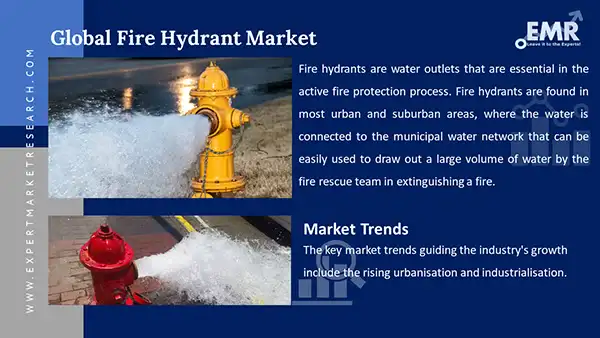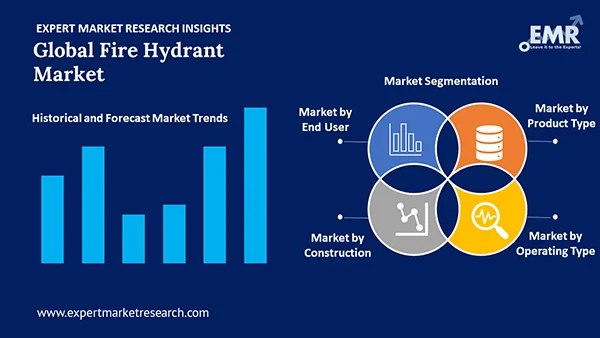
Consumer Insights
Uncover trends and behaviors shaping consumer choices today
Procurement Insights
Optimize your sourcing strategy with key market data
Industry Stats
Stay ahead with the latest trends and market analysis.
The global fire hydrant market stood at a value of around USD 1362.13 Million in 2025. The market is further expected to grow at a CAGR of 4.90% in the forecast period of 2026-2035 to attain a value of around USD 2197.73 Million by 2035.
Base Year
Historical Period
Forecast Period
Compound Annual Growth Rate
4.9%
Value in USD Million
2026-2035
*this image is indicative*
Based on product type, the dry barrel segment is estimated to occupy a significant share in the fire hydrant industry. This can be attributed to the increased use of dry barrel fire hydrants in regions with a colder climate. Dry barrel hydrants are designed for areas with lower temperatures, as the barrels above ground remain dry and the water main is located below the ground, which prevents it from freezing. In addition, with subsequent developments in fire hydrant systems worldwide, manufacturers are combining both the wet and dry barrel properties to create a hybrid fire hydrant, such as wet-top dry barrel hydrants, that could work in varied climates. This is expected to further aid the market in the forecast period.

Read more about this report - REQUEST FREE SAMPLE COPY IN PDF
North America is predicted to occupy a significant share of the global fire hydrant industry. This can be attributed to the stringent regulations put in place by the government and other regulatory agencies in the region. According to a report issued by the World Bank, fires cause more than 180,000 fatalities in a year globally, which is three times more than the annual average of natural hazards, and in the US alone, fire-related expenses amount to 1-2% of the GDP, annually. As a result, strict fire regulations are increasingly being implemented in order to reduce the risk of fires. These factors are expected to positively impact the market growth of fire hydrants in the forecast period.

Read more about this report - REQUEST FREE SAMPLE COPY IN PDF
Fire hydrants are water outlets that are essential in the active fire protection process. Fire hydrants are found in most urban and suburban areas, where the water is connected to the municipal water network that can be easily used to draw out a large volume of water by the fire rescue team in extinguishing a fire. These are found underneath the ground and aboveground. They come in bright red and yellow colours to increase their visibility, and sometimes have different coloured tops to indicate the volume of water a fire hydrant can deliver in gallons per minute (GPM), with blue having the highest GPM and red, the lowest. In addition, these hydrants are also used in water transfer and irrigation processes.
By product type, the market is distributed into:
On the basis of operating type, the industry can be categorised into:
Based on construction, the market can be segmented into:
On the basis of end user, the industry can be bifurcated into:
The regional markets for the product include:
According to the World Bank report dated October 2020, rapidly increasing urbanisation is a major cause of fires globally, and by 2050, two-third of the entire world's population would be living in cities. This, in turn, is leading to numerous issues such as fire hazards. Moreover, heightened industrialisation, especially in areas with high population density, is leading to the informal construction of commercial and residential buildings that do not meet the regulatory standards of fire safety and precautions and pose a major urban fire risk. In this regard, governments are increasingly investing in infrastructure planning and construction by utilising fire-resistant materials and installing fire hydrant systems. The growing installation of fire hydrant systems in and around the building to increase safety while efficiently decreasing the chances of a huge disaster is expected to aid the market in the forecast period.
The report gives a detailed analysis of the following key players in the global fire hydrant market, covering their competitive landscape, capacity, and latest developments like mergers, acquisitions, and investments, expansions of capacity, and plant turnarounds:
The comprehensive EMR report provides an in-depth assessment of the industry based on the Porter's five forces model and SWOT analysis.




*While we strive to always give you current and accurate information, the numbers depicted on the website are indicative and may differ from the actual numbers in the main report. At Expert Market Research, we aim to bring you the latest insights and trends in the market. Using our analyses and forecasts, stakeholders can understand the market dynamics, navigate challenges, and capitalize on opportunities to make data-driven strategic decisions.*
Get in touch with us for a customized solution tailored to your unique requirements and save upto 35%!
In 2025, the global fire hydrant market attained a value of nearly USD 1362.13 Million.
The market is projected to grow at a CAGR of 4.90% between 2026 and 2035.
The market is estimated to witness a healthy growth in the forecast period of 2026-2035 to reach USD 2197.73 Million by 2035.
The major drivers of the industry, such as the increased focus on safety in commercial and residential buildings, rising incidences of fire worldwide, increased investments by the government in the development of fire protection strategies, and rapid technological advancements, are expected to aid the market growth.
The key market trends guiding the industry's growth include the rising urbanisation and industrialisation.
The major regions in the industry are North America, Latin America, the Middle East and Africa, Europe, and the Asia Pacific.
The significant product types include dry barrel and wet barrel.
The major segments based on operating type include conventional and smart.
The significant segments based on construction include underground and aboveground.
The major end use segments include commercial and industrial.
The major players in the industry are American Cast Iron Pipe Company, AVK Holding A/S, EJ Group Inc., Kupferle Foundry Company, and others.
Explore our key highlights of the report and gain a concise overview of key findings, trends, and actionable insights that will empower your strategic decisions.
| REPORT FEATURES | DETAILS |
| Base Year | 2025 |
| Historical Period | 2019-2025 |
| Forecast Period | 2026-2035 |
| Scope of the Report |
Historical and Forecast Trends, Industry Drivers and Constraints, Historical and Forecast Market Analysis by Segment:
|
| Breakup by Product Type |
|
| Breakup by Operating Type |
|
| Breakup by Construction |
|
| Breakup by End User |
|
| Breakup by Region |
|
| Market Dynamics |
|
| Competitive Landscape |
|
| Companies Covered |
|
| Report Price and Purchase Option | Explore our purchase options that are best suited to your resources and industry needs. |
| Delivery Format | Delivered as an attached PDF and Excel through email, with an option of receiving an editable PPT, according to the purchase option. |
Single User License
One User
USD 3,999
USD 3,599
tax inclusive*
Datasheet
One User
USD 2,499
USD 2,249
tax inclusive*
Five User License
Five User
USD 4,999
USD 4,249
tax inclusive*
Corporate License
Unlimited Users
USD 5,999
USD 5,099
tax inclusive*
*Please note that the prices mentioned below are starting prices for each bundle type. Kindly contact our team for further details.*
Flash Bundle
Small Business Bundle
Growth Bundle
Enterprise Bundle
*Please note that the prices mentioned below are starting prices for each bundle type. Kindly contact our team for further details.*
Flash Bundle
Number of Reports: 3
20%
tax inclusive*
Small Business Bundle
Number of Reports: 5
25%
tax inclusive*
Growth Bundle
Number of Reports: 8
30%
tax inclusive*
Enterprise Bundle
Number of Reports: 10
35%
tax inclusive*
How To Order

Select License Type
Choose the right license for your needs and access rights.

Click on ‘Buy Now’
Add the report to your cart with one click and proceed to register.

Select Mode of Payment
Choose a payment option for a secure checkout. You will be redirected accordingly.
Gain insights to stay ahead and seize opportunities.

Get insights & trends for a competitive edge.

Track prices with detailed trend reports.

Analyse trade data for supply chain insights.

Leverage cost reports for smart savings

Enhance supply chain with partnerships.

Connect For More Information
Our expert team of analysts will offer full support and resolve any queries regarding the report, before and after the purchase.
Our expert team of analysts will offer full support and resolve any queries regarding the report, before and after the purchase.
We employ meticulous research methods, blending advanced analytics and expert insights to deliver accurate, actionable industry intelligence, staying ahead of competitors.
Our skilled analysts offer unparalleled competitive advantage with detailed insights on current and emerging markets, ensuring your strategic edge.
We offer an in-depth yet simplified presentation of industry insights and analysis to meet your specific requirements effectively.
Share